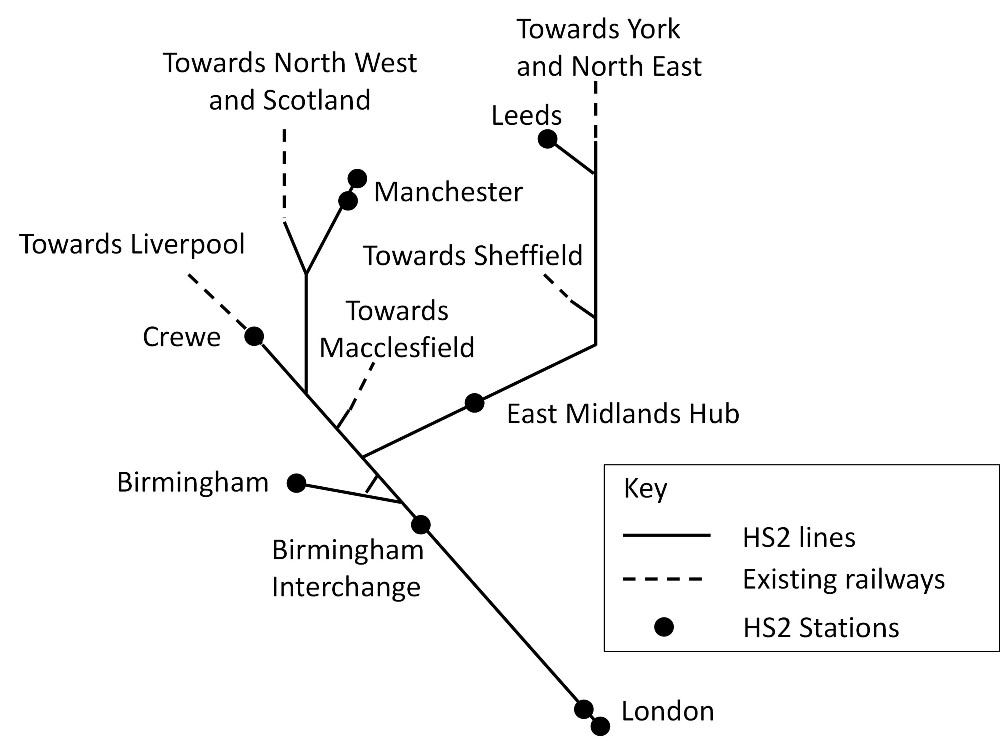FEATURED PAPER
By Martin Hopkinson
United Kingdom
HS2 is the UK’s future high speed railway network. The project’s initial objective was to provide an additional 134 mile high speed rail link from London to the centre of Birmingham. After a series of delays, the UK Government’s current plan is to have this link, HS2 Phase 1, in operation by 2029. The plans for HS2 have also been extended to build additional high speed rail links North of Birmingham. The first of these links is covered by the HS2 Phase 2a plan to extend the line to Crewe through the West of England. Phase 2a will enable connections to be made via existing traditional (lower speed) railway lines with terminal points in Liverpool and Macclesfield. It is also planned for completion in 2029.
Further extensions to the HS2 network are covered by the Phase 2b plan due to complete in 2035. Phase 2b will provide high speed connections to Manchester and Leeds and three further links to existing railways, providing reach to Sheffield, the North East of England (through to Newcastle) and through the North West of England and Scotland (to Edinburgh and Glasgow). Figure 1 is a simplified version of the overall network figure that can be viewed on the HS2 website 1 and shows why it is often described as resembling a Y figure.

Figure 1: The HS2 network and its connections with existing (traditional) railways
The project has always been controversial. One reason for this has been its escalating cost. HS2 has become exceptionally expensive with a project delivery cost likely to exceed £100bn at 2020 rates. Opponents of the project have also questioned the basis for calculating the economic benefits of reduced journey times. Despite this, the Government’s calculation of the Benefit Cost Ratio (BCR) has remained favourable. This paper challenges the assumptions that lie behind this calculation. In doing so, it illustrates the sensitivity that a BCR calculation has to a combination of challenges to both a project’s cost and its benefits.
The Department for Transport Business Case
On 11th February 2020 the Prime Minister, Boris Johnson announced that the government was committed to building both Phase 1 and Phase 2. The Project Notice to Proceed (NtP) to industry followed two months later on 15th April. The Government’s project business case for Phase 1, signed by Andrew Stephenson MP, Minister of State at the Department for Transport (DfT), was issued in the same month 2. Table 1 below shows the BCR calculation from that document. The figures are based on present values at 2015 rates and exclude sunk costs, of approximately £6bn. The benefits estimates are based on the first 60 years of planned service.
More…
To read entire paper, click here
How to cite this paper: Hopkinson, M. (2020). High Speed Rail: HS2 – A Project Business Case in Crisis; PM World Journal, Vol. IX, Issue XII, December. Available online at https://pmworldlibrary.net/wp-content/uploads/2020/12/pmwj100-Dec2020-Hopkinson-HS2-a-project-business-case-in-trouble.pdf
About the Author

Martin Hopkinson
United Kingdom
![]()
Martin Hopkinson is the Director of Risk Management Capability Limited and has 30 years’ experience as a project manager, project risk management specialist and consultant. His experience has been gained across a wide variety of industries and engineering disciplines and includes multi-billion pound projects and programmes.
Martin’s first book, The Project Risk Maturity Model, concerns the risk management process. His contributions to Association for Project Management (APM) guides such as Directing Change and Sponsoring Change reflect his belief in the importance of project governance and business case development.
In his most recent book Net Present Value and Risk Modelling for Projects he brings these subjects together by showing how NPV and risk modelling techniques can be used to optimise projects and support project approval decisions. (To learn more about the book, click here.)









